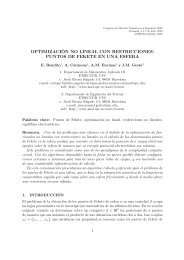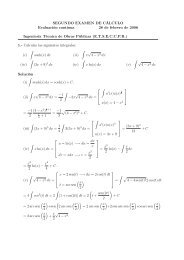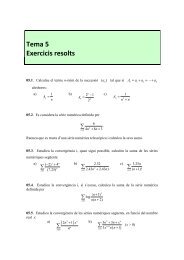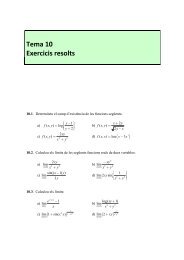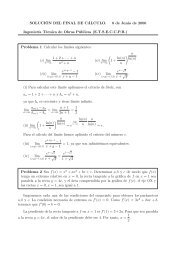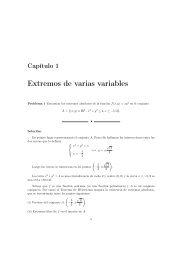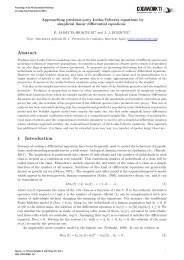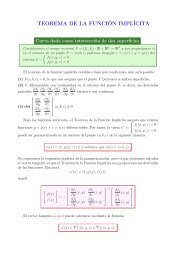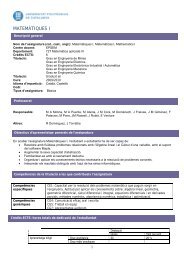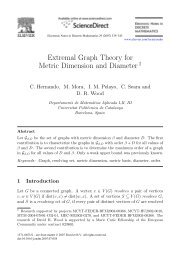Problemas de diferenciabilidad y geométricos
Problemas de diferenciabilidad y geométricos
Problemas de diferenciabilidad y geométricos
Create successful ePaper yourself
Turn your PDF publications into a flip-book with our unique Google optimized e-Paper software.
10 Índice general<br />
Por tanto,<br />
⎛<br />
∇f(x, y) = ⎜<br />
⎝<br />
y 2 sin(x 2 + y 2 ) + 2x 2 (x 2 + y 2 ) cos(x 2 + y 2 ⎞<br />
)<br />
(x 2 + y 2 ) 3/2<br />
⎟<br />
xy(2(x 2 + y 2 ) cos(x 2 + y 2 ) − sin(x 2 + y 2 ) ⎠<br />
(x 2 + y 2 ) 3/2<br />
(ii) La <strong>de</strong>rivada direccional <strong>de</strong> una función diferenciable según un vector v en el punto (a, b)<br />
es D v f(a, b) = 〈∇f(a, b), v〉. En nuestro caso v = √ 1<br />
2<br />
(1, 1). Calculamos en primer lugar el<br />
vector gradiente en el punto indicado: ∇f( √ π, 0) = (−2 √ π, 0). Finalmente,<br />
D v f( √ π, 0) = √ 1 〈(1, 1), (−2 √ π, 0)〉 = − √ 2π<br />
2<br />
Problema 5 Sea f : IR 2 − {(0, 0)} −→ IR <strong>de</strong>finida por:<br />
f(x, y) =<br />
xy sen(x + y)<br />
√<br />
x2 + y 2<br />
(i) Estudiar la <strong>diferenciabilidad</strong> <strong>de</strong> f en IR 2 y hallar el gradiente <strong>de</strong> f para todo (x, y) ∈ IR 2 .<br />
(ii) Hallar el plano tangente a la superficie z = f(x, y) en el punto (0, π/2).<br />
Solución:<br />
•<br />
(i) f es diferenciable en IR 2 − {(0, 0)} por ser composición, producto y cociente <strong>de</strong> funciones<br />
elementales y no anularse el <strong>de</strong>nominador. Calculamos ahora las <strong>de</strong>rivadas parciales.<br />
D 1 f(x, y) =<br />
(y sen(x + y) + xy cos(x + y)) √ x 2 + y 2 x<br />
− xy sen(x + y) √<br />
x 2 +y 2<br />
x 2 + y 2 =<br />
(x 2 + y 2 )y(sen(x + y) + x cos(x + y)) − x 2 y sen(x + y)<br />
(x 2 + y 2 ) 3/2<br />
√<br />
y<br />
x2 +y 2<br />
(x sen(x + y) + xy cos(x + y)) √ x 2 + y 2 − xy sen(x + y)<br />
D 2 f(x, y) =<br />
x 2 + y 2 =<br />
Por tanto,<br />
(x 2 + y 2 )x(sen(x + y) + y cos(x + y)) − xy 2 sen(x + y)<br />
(x 2 + y 2 ) 3/2<br />
∇f(x, y) =<br />
⎛<br />
⎜<br />
⎝<br />
(x 2 + y 2 )y(sen(x + y) + x cos(x + y)) − x 2 ⎞<br />
y sen(x + y)<br />
(x 2 + y 2 ) 3/2<br />
⎟<br />
(x 2 + y 2 )x(sen(x + y) + y cos(x + y)) − xy 2 sen(x + y) ⎠<br />
(x 2 + y 2 ) 3/2



